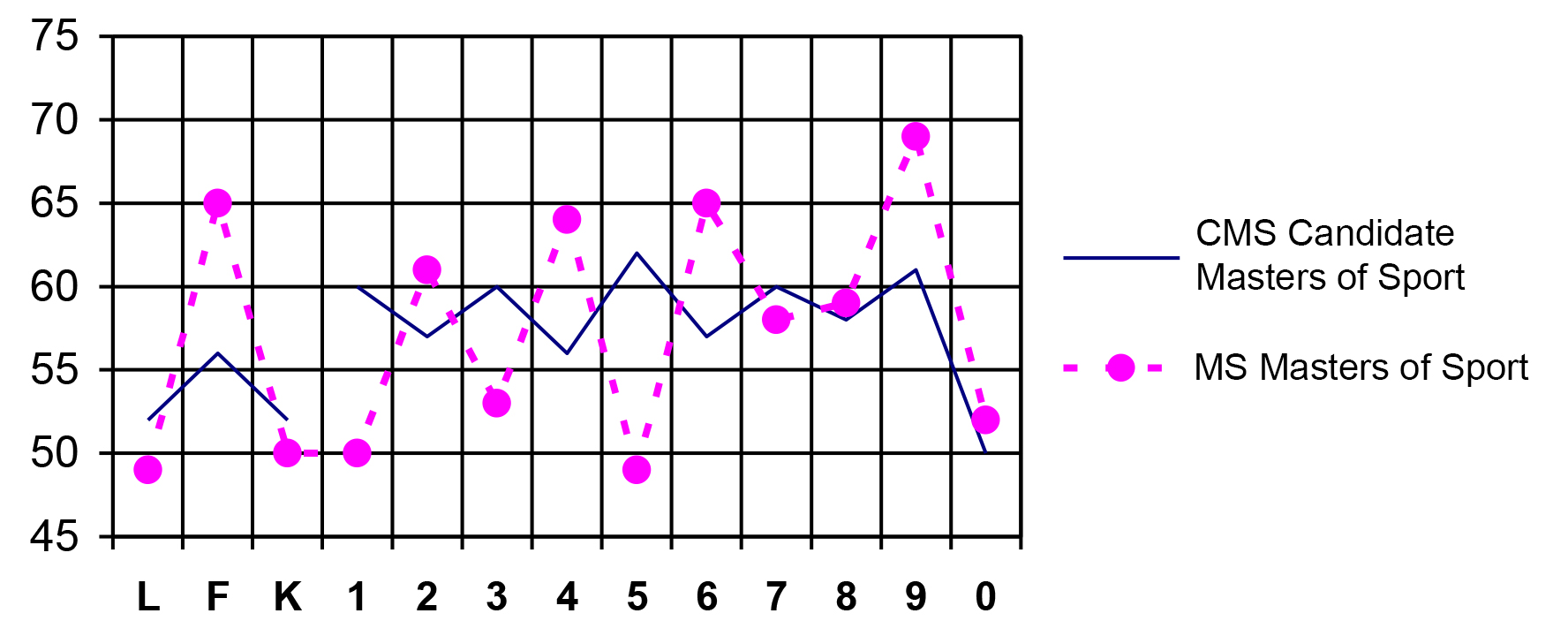Psychological profile of ice hockey team coach
Фотографии:
ˑ:
An Tzin1
Dr.Sc.Phil., PhD, Professor G.M. Biryukova2
1Wuhan University of Physical Education and Sports, Laboratory of Control and Assessment of Professional Competency, Wuhan City, Hubei Province, China
2Lesgaft National State University of Physical Education, Sport and Health, Saint Petersburg
Keywords: balance of nervous processes, emotional lability, success rate.
Background. At this juncture a few problems with concern to correlations of the personality qualities of sport coaches with the individual/ team competitive success rates of their trainees; and problems arising in the coach-trainee relationship system are still underexplored in modern research literature.
Methods and structure of the study. Subject to the study were 32 ice hockey team coaches (aged 35 on average) in their professional development course at Lesgaft National State University of Physical Education, Sport and Health. The subjects were tested using the following two test methods: Standard Multifactor Personality Test (SMPT) designed to test and profile individual personality qualities and Response to Moving Object Test (RMOT) rating the balance of nervous processes (BNP). The test data were subject to statistical processing and analysing using a non-computerised procedure.
The Response to Moving Object Test (RMOT) makes it possible to analyse the BNP as one of the individual neurodynamic qualities and thereby rate the bodily energy level on the whole and brain level in particular. The test generated the data on the individually specific bodily activation levels of direct influence on the individual behavioural control patterns. The balance of nervous processes (BNP) was rated by the following test components:
|
1) |
Late and early responses were fixed in the test, with the increased share of early responses interpreted as indicative of the excitation processes being dominant; |
|
2) |
Average deviation of the marker from the target was rated in %, with positive values interpreted as indicative of the excitation processes being dominant. |
The above test data were used to calculate the nervous process balance rates including accuracy (Ac), stability (St) and excitation (Ex) rates; plus the excitation trend (ExT) values.
Study results and discussion. The test data were averaged to generate SMPT profiles and were interpreted as showing the psychological profiles of the subject ice hockey team coaches being fairly balanced: see Table 1 hereunder.
Table 1. SMPT versus BNP data correlations
|
SMPT scales |
Accuracy |
Stability |
Excitation |
Excitation trend |
|
L |
0,015 |
-0,151 |
-0,247 |
-0,044 |
|
F |
-0,014 |
-0,031 |
-0,029 |
-0,296 |
|
K |
-0,075 |
-0,255 |
0,205 |
-0,343 |
|
1 |
-0,180 |
-0,069 |
-0,213 |
-0,151 |
|
2 |
0,179 |
-0,150 |
0,142 |
-0,150 |
|
3 |
-0,060 |
-0,014 |
-0,040 |
-0,342 |
|
4 |
0,079 |
-0,112 |
0,374 |
-0,050 |
|
5 |
0,057 |
0,079 |
0,020 |
-0,450 |
|
6 |
-0,181 |
-0,044 |
-0,167 |
-0,114 |
|
7 |
0,008 |
-0,114 |
0,159 |
-0,195 |
|
8 |
-0,071 |
-0,195 |
0,155 |
-0,412 |
|
9 |
-0,062 |
0,149 |
0,098 |
-0,142 |
|
0 |
-0,018 |
-0,200 |
-0,036 |
-0,118 |
The above data show that most of the subjects may be characterised by active life standings; expressed determination in the goal achievement domain; predisposition for a teamwork; ability to abide by the rules and regulations; expressed competitive spirit; optimism; and high self-esteem.
One of the hypotheses the study was designed to check was based on the assumption that the top-ranking (i.e. highly qualified and titled) coaches should show higher balanced individual professional and psychological control rates and have more successful trainees in their coaching careers versus the lower-ranking (i.e. lower qualified and untitled) coaches.

Figure 1. Averaged personality profiles generated by the SMPT
The study data were interpreted as showing the following:
- The personality traits of the CMS-qualified coaches were indicative of an underdeveloped determination in the goal achievement domain associated with insufficient levels of competitive spirit, combative aggression and expressed reluctance in competitive relationship. The MS-qualified coachers were tested with high determination in the goal achievement domain associated with high competitive/ confrontation spirit;
- The high self-esteem rates were associated with the optimistic attitudes to future, ability to take independent decisions and take a constructive position in challenging situations.
The data given above in Table 1 show the Ac and St test data lacking significant correlations with the SMPT data.
Data generated by sub-test 4 (expressed motivation for achievement) were found to positively correlate with Ex (excitation process) rates; and this means that the subject first aspires something followed by the individual competitive spirit being activated as verified by the growing excitation rate to mobilise the body and come to the combative status. Statistical survey of the coaches with the expressed motivations for success and domination (24% of the sample) showed their trainees being quite successful in the sport careers, namely: A. Egorov in Spartak FC, 2000; S. Korobov, SKA FC goalkeeper; 4 trainees, winner of the Russian Golden Pack Tournaments n.a. A.V. Tarasov; 2 trainees qualified for the Russian national teams; 1 trainee qualified for the World Floorball Championship and a silver medallist at the Junior Olympics; 8 trainees being qualified Masters of Sport; and 30 trainees being qualified CMS.
Data generated by sub-test 5 (gender-role-specific behaviour) showed a significant negative correlation with ExT data (indicative of the excitation-to-inhibition and vice versa switchover speeds). The test data may be indicative of the inadequate decisiveness and courage in the behavioural patterns when facing unexpected and potentially dangerous situations; and the data that may be interpreted as a sag in masculinity rates.
Data generated by sub-test 8 on the SMPT scale show a significant negative correlation with the ExT rates that may be indicative of a predisposition for analysis of own decisions and actions free of emotional responses when the occasion requires from the subject to be actively engaged in the process.
Conclusion. The Standard Multifactor Personality Test (SMPT) and Response to Moving Object Test (RMOT) rating the balance of nervous processes (BNP) give the means to obtain the coaches’ psychological profiles. The lower is the ritualistic aspect in the coach’s personality the higher is his masculinity; and the higher is the probability of an addictive behaviour the higher is the individual control rate. It was also found that the higher skilled coaches (with high qualifications and titles) tend to be more impulsive being psychologically better balanced for their vocational sport activity at the same time and, as a result, their trainees are generally more successful versus the ones of unqualified coaches having no titles.
References
- Apparatno-programmny psikhodiagnosticheskiy kompleks «Multipsikhometr». Metod. rukovodstvo. Ch. II [Hardware-software psychodiagnostic complex "Multipsychometer". Guide. Part II]. Moscow: Research and Production Center «DIP» publ., 2016, pp. 5-12.
- Kuteynikov A.N. Matematicheskie metody v psikhologii. Ucheb. posobie [Mathematical methods in psychology. Study guide]. St. Petersburg: Rech publ., 2008, 172 p.
- Lovyagina A.E., Ilyina N.L., Volkov D.N. Psikhologiya fizicheskoy kultury i sporta. Uchebnik i praktikum dlya akademicheskogo bakalavriata [Psychology of physical culture and sports. Textbook and workshop for academic bachelor's course]. Moscow: Yuoright publ., 2016, pp. 223-244.
- Sobchik L.N. Standartizirovanny mnogofaktorny metod issledovaniya lichnosti SMIL [Standardized multifactorial method of personality studies MMPI]. St. Petersburg: Rech publ., 2002, 219 p.
Corresponding author: Gal.mi@mail.ru
Abstract
Objective of the study was to outline the key psychological traits of an ice hockey team coach using a variety of methods including Standard Multifactor Personality Test (SMPT) and Response to Moving Object Test (RMOT). Subject to the study were 32 coaches. The study data and analysis made it possible to generate an average personality profile of an ice hockey team coach and find, among other things, the following: the lower is the ritualistic aspect in the coach’s personality the higher is his masculinity; the higher is the probability of addictive behaviour (4th scale of SMPT) the higher is the individual control rate. It was also found that the higher skilled coaches (with high qualifications and titles) tend to be more impulsive being psychologically better balanced for their vocational sport activity at the same time and, as a result, their trainees are generally more successful versus the ones of unqualified coaches having no titles.



